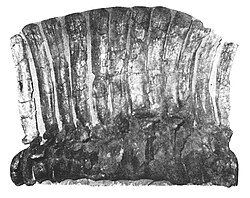Barsboldia
|
Barsboldia Temporal range: Late Cretaceous, 70 Ma |
|
|---|---|
 |
|
| Sacrum of the holotype | |
| Scientific classification | |
| Kingdom: | Animalia |
| Phylum: | Chordata |
| Class: | Sauropsida |
| Order: | Ornithischia |
| Family: | Hadrosauridae |
| Subfamily: | Saurolophinae |
| Genus: |
Barsboldia Maryańska & Osmólska, 1981 |
| Species | |
|
|
Barsboldia (meaning "of Barsbold", a well-known Mongolian paleontologist) was a genus of large hadrosaurid dinosaur from the early Maastrichtian Nemegt Formation of Ömnogöv', Mongolia. It is known from a partial vertebral column, partial pelvis, and some ribs.
Teresa Maryańska and Halszka Osmólska based this genus on ZPAL MgD-1/110, a partial skeleton consisting of nine back vertebrae, nine hip vertebrae, fifteen tail vertebrae, a left ilium, parts of the left and right pubis, several ribs, and a few fragments of the hind limbs, with the backbone largely articulated. The most distinctive features of this skeleton are found in the neural spines. These are very tall, particularly over the hips, and were described as second only to those of Hypacrosaurus altispinus and the tips of those found in the first few vertebrae of the tail are club-shaped (possibly a sign of old age).
Maryańska and Osmólska described their new genus as a lambeosaurine (or hollow-crested duckbill), the first from the Nemegt Formation, although it lacked a skull. However, the sacrum has a keel along the bottom, a possible lambeosaurine feature, and the bones closely resemble those of Hypacrosaurus. With only one partial skeleton known, and no skull, the genus has been considered dubious or a possible lambeosaurine of uncertain placement. A newer study published in 2011 suggests that Barsboldia is actually a valid saurolophine.
...
Wikipedia
